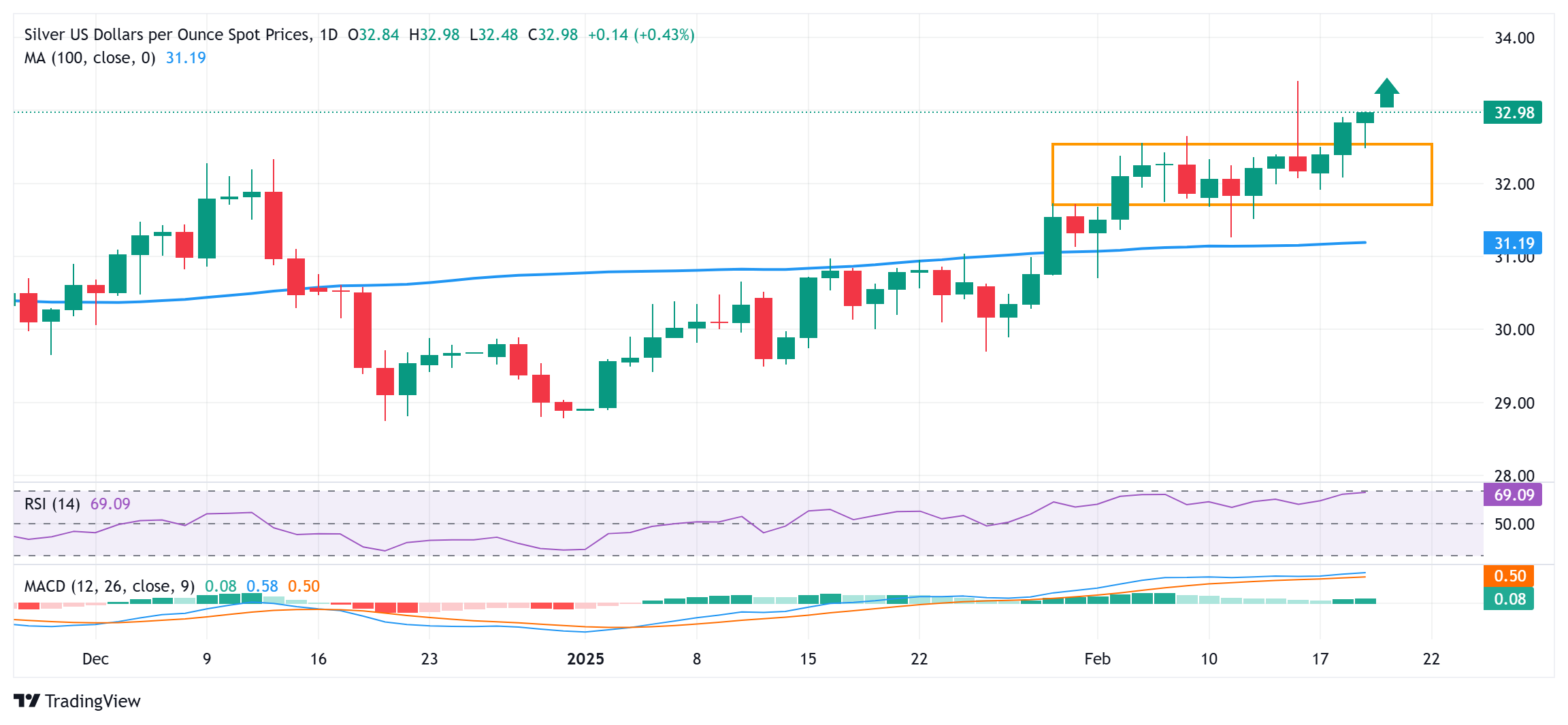Silver Price Forecast: XAG/USD seems poised to retest multi-month top, around $33.40 area
- Silver turns positive for the third straight day and climbs to a fresh weekly high.
- The technical setup favors bulls and supports prospects for further appreciation.
- Any corrective slide toward $32.00 might now be seen as a buying opportunity.
Silver (XAG/USD) attracts some dip-buyers in the vicinity of the $32.00 round figure and turns positive for the third consecutive day on Wednesday. The white metal climbs to a fresh weekly high during the first half of the European session, with bulls now looking to build on the momentum beyond the $33.00 mark.
From a technical perspective, the overnight sustained close above the $32.50-$32.55 hurdle confirmed a fresh breakout through a short-term trading range and favors bullish traders. This, along with positive oscillators on the daily chart, suggests that the path of least resistance for the XAG/USD remains to the upside and supports prospects for additional gains.
The white metal now seems poised to advance further towards last Friday's swing high, around the $33.35-$33.40 zone before aiming to reclaim the $34.00 round-figure mark. The momentum could extend further towards the $34.45 intermediate hurdle and eventually lift the XAG/USD to the $35.00 neighborhood, or the multi-year peak touched in October.
On the flip side, any meaningful corrective pullback now seems to find decent support near the $32.00-$31.90 region. A further slide could be seen as a buying opportunity, which, in turn, should limit the downside for the XAG/USD near the $31.75-$31.70 horizontal zone. A convincing break below the latter might shift the near-term bias in favor of bearish traders.
The XAG/USD might then accelerate the fall towards retesting the 100-day Simple Moving Average (SMA), currently pegged near the $31.20 area, en route to the $31.00 round figure mark. Some follow-through should pave the way for a fall toward the next relevant support near the $30.25 region, the $30.00 psychological mark, and the $29.55-$29.50 horizontal zone.
Silver daily chart

Silver FAQs
Silver is a precious metal highly traded among investors. It has been historically used as a store of value and a medium of exchange. Although less popular than Gold, traders may turn to Silver to diversify their investment portfolio, for its intrinsic value or as a potential hedge during high-inflation periods. Investors can buy physical Silver, in coins or in bars, or trade it through vehicles such as Exchange Traded Funds, which track its price on international markets.
Silver prices can move due to a wide range of factors. Geopolitical instability or fears of a deep recession can make Silver price escalate due to its safe-haven status, although to a lesser extent than Gold's. As a yieldless asset, Silver tends to rise with lower interest rates. Its moves also depend on how the US Dollar (USD) behaves as the asset is priced in dollars (XAG/USD). A strong Dollar tends to keep the price of Silver at bay, whereas a weaker Dollar is likely to propel prices up. Other factors such as investment demand, mining supply – Silver is much more abundant than Gold – and recycling rates can also affect prices.
Silver is widely used in industry, particularly in sectors such as electronics or solar energy, as it has one of the highest electric conductivity of all metals – more than Copper and Gold. A surge in demand can increase prices, while a decline tends to lower them. Dynamics in the US, Chinese and Indian economies can also contribute to price swings: for the US and particularly China, their big industrial sectors use Silver in various processes; in India, consumers’ demand for the precious metal for jewellery also plays a key role in setting prices.
Silver prices tend to follow Gold's moves. When Gold prices rise, Silver typically follows suit, as their status as safe-haven assets is similar. The Gold/Silver ratio, which shows the number of ounces of Silver needed to equal the value of one ounce of Gold, may help to determine the relative valuation between both metals. Some investors may consider a high ratio as an indicator that Silver is undervalued, or Gold is overvalued. On the contrary, a low ratio might suggest that Gold is undervalued relative to Silver.

